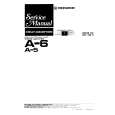|
|
|
Productos
|
|
Información
|
|
Destacado
|
|
|
 |
|
|
No hay comentarios de productos.
03
Connecting up
Speaker terminals
1
10mm
2
3
� To achieve the best possible surround sound, install your speakers as shown below. Be sure all speakers are installed securely to prevent accidents and improve sound quality. Caution
1
Twist exposed wire strands together.
2 Loosen speaker terminal and insert exposed wire. Make sure that all the bare speaker wire is twisted together and inserted fully into the speaker terminal. Use good quality speaker wire to connect the speakers to the receiver. 3 Tighten terminal.
� If you choose to install the center speaker on top of the TV, be sure to secure it with putty, or by other suitable means, to reduce the risk of damage or injury resulting from the speaker falling from the TV in the event of external shocks such as earthquakes.
Overhead view of speaker setup
You can also refer to the 3-D speaker setup illustration on page 10.
Front Left Front Right
Hints on speaker placement
Speakers are usually designed with a particular placement in mind. Some are designed to be floorstanding, while others should be placed on stands to sound their best. Some should be placed near a wall; others should be placed away from walls. We have provided a few tips on getting the best sound from your speakers (following), but you should also follow the guidelines on placement that the speaker manufacturer provided with your particular speakers to get the most out of them. � Place the front left and right speakers at equal distances from the TV. � When placing speakers near the TV, we recommend using magnetically shielded speakers to prevent possible interference, such as discoloration of the picture when the TV is switched on. If you do not have magnetically shielded speakers and notice discoloration of the TV picture, move the speakers farther away from the TV. � If you're using a center speaker, place the front speakers at a wider angle. If not, place them at a narrower angle. � Place the center speaker above or below the TV so that the sound of the center channel is localized at the TV screen. Also, make sure the center speaker does not cross the line formed by the leading edge of the front left and right speakers. � It is best to angle the speakers towards the listening position. The angle depends on the size of the room. Use less of an angle for bigger rooms. � Surround and surround back speakers should be positioned 60 cm�90 cm higher than your ears and titled slight downward. Make sure the speakers don't face each other. For DVD-Audio, the speakers should be more directly behind the listener than for home theater playback.
Center
Subwoofer
Surround Left
Surround Right
Listening Position
Surround Back Left
Surround Back Right
Single Surround Back Speaker
The diagrams below show suggested surround and surround back speaker orientation. The first diagram (fig. A) shows orientation with one surround back speaker (or none) connected. The second (fig. B) shows orientation with two surround back speakers connected.
90~120
LS RS LS RS
0~60
LS SB
RS
SBL
SBL
SBR
SBR
fig. A
fig. B
� If you have two surround back speakers THX recommends placing them together and the same distance from your listening position.
22
En
|
|
 |
> |
|

